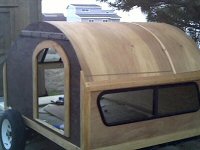Whatever epoxy system you decide on....they all take the same steps. I think the number one thing you need to consider is just how high of a finish you would like. All the top coats for wood for finishing bright take multiple layers of material to build up and give the finish some depth. You can seal it with just a couple of coats, but if you want it nice and flat and with the type of finish like a car hood, something you can wax, takes time and coats. That's a corner that you can't cut if you want that look.
I've built several boats and a couple of woody tears all finished "bright", meaning, natural wood finish appearance. On the tears, I've never used cloth, but then I don't do the roofs on them in wood, just the side walls. Once it is coated out in epoxy, you really need to build up the finish so that it's flat and gives it some depth. All those little dimples will show when it's done if you don't do this. The top finish won't hide anything, it's all in the pre-top coat work. Whether or not that's important to you is all your decision. Typically, I do like at least 7 coats of epoxy so it's really flat...then shoot it with auto clear.
An advantage to an auto clear is that it holds up over time much better than a varnish...the downside is that it takes more equipment/ money/ time and skill to do it. You can do all the prep work and have it shot by a paint shop if you can't spray the material. Just how much time it spends outdoors will determine just how much maintenance your finish will need.
Any natural finished wood is going to take more maintenance than a painted object. Paint really cuts down on the UV problems, better than a clear. The West system "special coat" catalyst has a UV inhibitor built in, that's why it has a slight amber cast. Regardless....no epoxy finish can be left without a top coat of some sort of finish. Just how nice you want it to look is up to you and the effort you want to put into it. A lesser top coat will take more maintenance over time.
My first built tear is nearly 8 now, has changed hands 3 times, and the last time I saw it, it did need some attention to the outer maple trim on it on the lower trim, but is still a presentable tear. I've learned a lot about how to do the trim since then. They all eventually need some maintenance.
Just think of epoxy as a plastic coat that you are putting over the wood. All the edges need to be eased and all gaps filled...a sharp edge won't hold the epoxy and a gap will allow water in. Also...make sure that whatever color tint, IE stain you put on is compatible with an epoxy. I prefer the water based aniline dyes as they are really forgiving when applying, and can be mixed to your specs. Available through most woodworking sites.
Blushing is typically an indicator that you have a moisture or high humidity issue when curing. If you are doing this outdoors in the fall....yeah, it might be a problem. I can build in a garage with a wood stove so I've never had a problem with it. Watch your environmental conditions when applying. You can't put the epoxy on....then push it out on a cool damp night and not have a problem.
Not to beat a horse dead....cut a corner now...redo it later. Just my opinions, others will differ. Doug
Need advice from Woody owners on the exterior finishing.
23 posts
• Page 2 of 2 • 1, 2
Re: Need advice from Woody owners on the exterior finishing.
Hey Doug - Thanks for your input. My learning curve on Epoxy has been pretty steep in the last couple weeks. I have a climate controlled garage where my TD will be finished and stored any time it is not in use. I have ordered enough RAKA epoxy for approximately six coats. I had planned to stain with Minwax gel stain but they advise the use of water based stains only. After reading Mike's comments about water based stains in the Generic Benroy plans, I am a little concerned about my ability to get a good result. I am planning to use the RAKA with UV inhibitor and then finishing it with Mon-o-War spar varnish. I will plan to re-coat every couple years.
You said in your post that you don't finish your roof in wood. What is your preferred method. I have been thinking of 1/8" Baltic Birch under .040 aluminum but no firm plan yet. This is great fun. I wish I had built it six years ago when I first retired. Thanks to you and all the others for the help. Bill
You said in your post that you don't finish your roof in wood. What is your preferred method. I have been thinking of 1/8" Baltic Birch under .040 aluminum but no firm plan yet. This is great fun. I wish I had built it six years ago when I first retired. Thanks to you and all the others for the help. Bill
-

kookenotes - Teardrop Advisor
- Posts: 70
- Images: 71
- Joined: Mon Aug 06, 2012 11:55 am
- Location: Roswell, Ga.

 Mine will also reside in the garage when I'm not using it. This has really been a great learning experience and I really appreciate all of the information and advice that I have gotten from everyone. I can't wait to get it finished and in use. Bill
Mine will also reside in the garage when I'm not using it. This has really been a great learning experience and I really appreciate all of the information and advice that I have gotten from everyone. I can't wait to get it finished and in use. Bill